ETS warning!
in the last year alone but farm gate prices for vegetables have lagged below growers’ cost inflation.
VEGETABLE GROWERS are warning that an emissions trading scheme (ETS) will only push up prices of produce, lower consumption and make them less competitive in export markets.
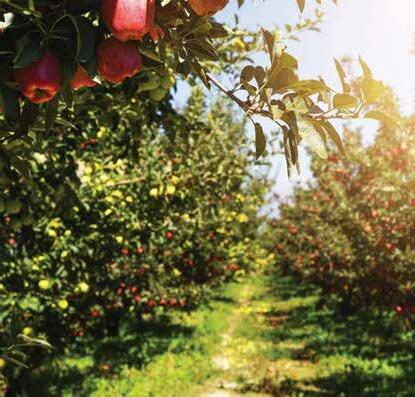
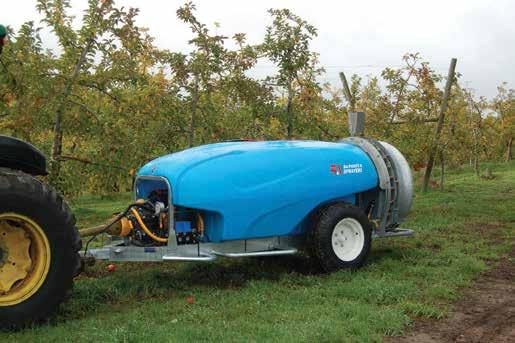
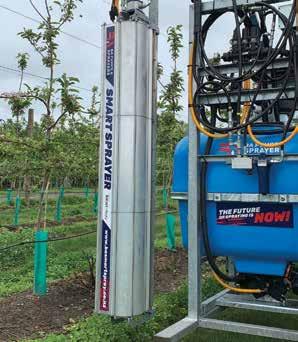
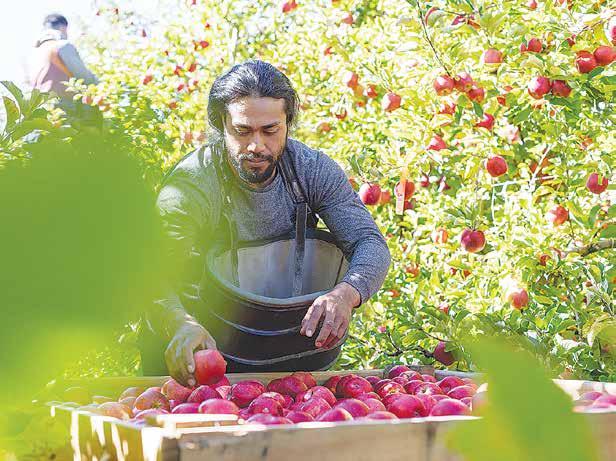
In a joint submission to the Ministry for Environment (MfE) two weeks ago, Potatoes New Zealand and Vegetables NZ (VNZ) say they object in principle to being brought into ETS – either directly or via the mechanisms proposed in the consultation document, Pricing agricul tural emissions.
They claim the proposal isn’t effec tive, practical or equitable.
They point out that fresh vegetable and potato growers collectively account for only 0.032% of all agricultural emis sions and should be exempt, as are other minor contributors.
“If the emissions levy were to be increased to a point that it would create change, that change would be entirely counter-productive and result in exac erbating the cost-of living crisis, a loss of national income from vegetable exports (and corresponding increases in food imports), and a very real threat to New Zealand’s food security and health outcomes,” the submission says.
“This would be a direct contradic tion of the 2015 Paris Agreement to safeguard food security while manag ing climate change.”
The submission notes that vegetable grower input costs have experienced significant inflation ahead of prices.
Labour costs have increased by more than 4.5% per annum since 2015, and fertiliser prices increased by over 63%
The submission says a study con ducted earlier this year by VNZ con cluded farm-gate prices increased just 1.7% per annum over the period 20152022 - this being only half the rate of retail price inflation for vegetables.
“In consequence, we estimate the average vegetable grower’s margin may have halved over the last decade.”
About 80% of fresh vegetables are
grown for the domestic market.
The submission says as a result of tight growing margins, any mate rial emissions levy for growers would simply increase the price of domes tic vegetables, with a corresponding reduction in fresh vegetable consump tion, especially for the most vulnera ble low socio-economic communities.
“Fresh vegetables are a highly price sensitive category.


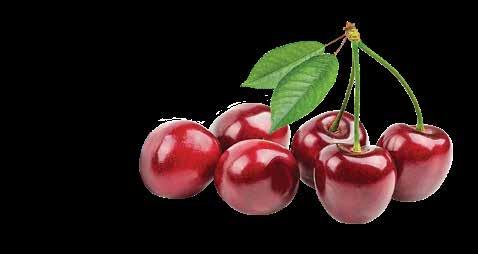
“Further price increases, especially with the cost-of-living crisis, are esti
mated to have a significant impact on New Zealanders’ welfare and national health costs.”
New Zealand vegetable growers could also become uncompetitive in wider export markets, threatening $700m worth of export trade income.
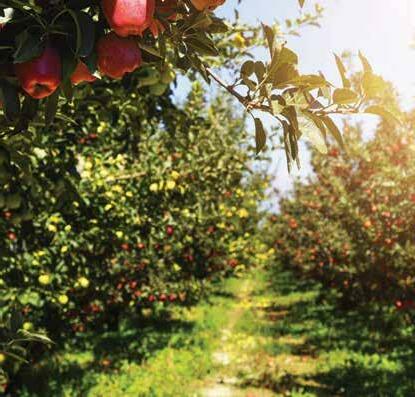
The submission points out that no other nation is bringing their agri cultural sector into emissions trad ing scheme or implementing a similar emissions levy, and so this could be a significant competitive disadvantage
for New Zealand growers who supply export markets.
“Even more concerning, other nations may see opportunity to enter and expand vegetable imports into New Zealand.
“The dumping of subsidised Euro pean potato products into the New Zealand market during 2020 as Covid hit domestic sales in the EU is a har binger of what could occur.”
@rural_news facebook.com/ruralnews
about
seems to be a key reason why bright, young people are not signing up to do degrees that would take them into careers in the sector.
Massey Universities College of Agriculture and Environment head Professor Paul Kenyon says the university is not getting the number of students through its doors that the sector is demanding in terms of potential jobs. He says it’s a struggle to get young people and their families to understand that there are real, high-value career opportunities in horticulture. See full story page 3
HORTNEWS DECEMBER 2022, ISSUE 28 ISSN 2624-3490 (print) ISSN 2624-3504 (online) WWW.HORTNEWS.CO.NZ New Zealand cherries on – Page 12
Sudesh Kissun sudeshk@ruralnews.co.nz
BETTER WORK STORIES! Negative
perceptions
horticulture
BA ORCHARD SPRAYER 2000 or 3000 litre models 920mm fan with 2 speed gearbox 10 roll over nozzles per side Manual, electric or autorate control SMARTSPRAYER® Up to 93% reduction in spray loss on the ground Up to 87% reduction in airborne drift Up to 73% reduction of spray consumption *As per research by USDA Talk to our spraying experts to help with your horticultural spraying requirements. 0800 833 538 | www.bapumpsandsprayers.com THE EST ROUND
CREDIT: PAUL SUTHERLAND PHOTOGRAPHY
Keeping ahead of Mother Nature
A KIWI-MADE technol ogy platform is giving a Bay of Plenty orchard manager the edge when it comes to weather fore casting and managing pests and diseases on his property.
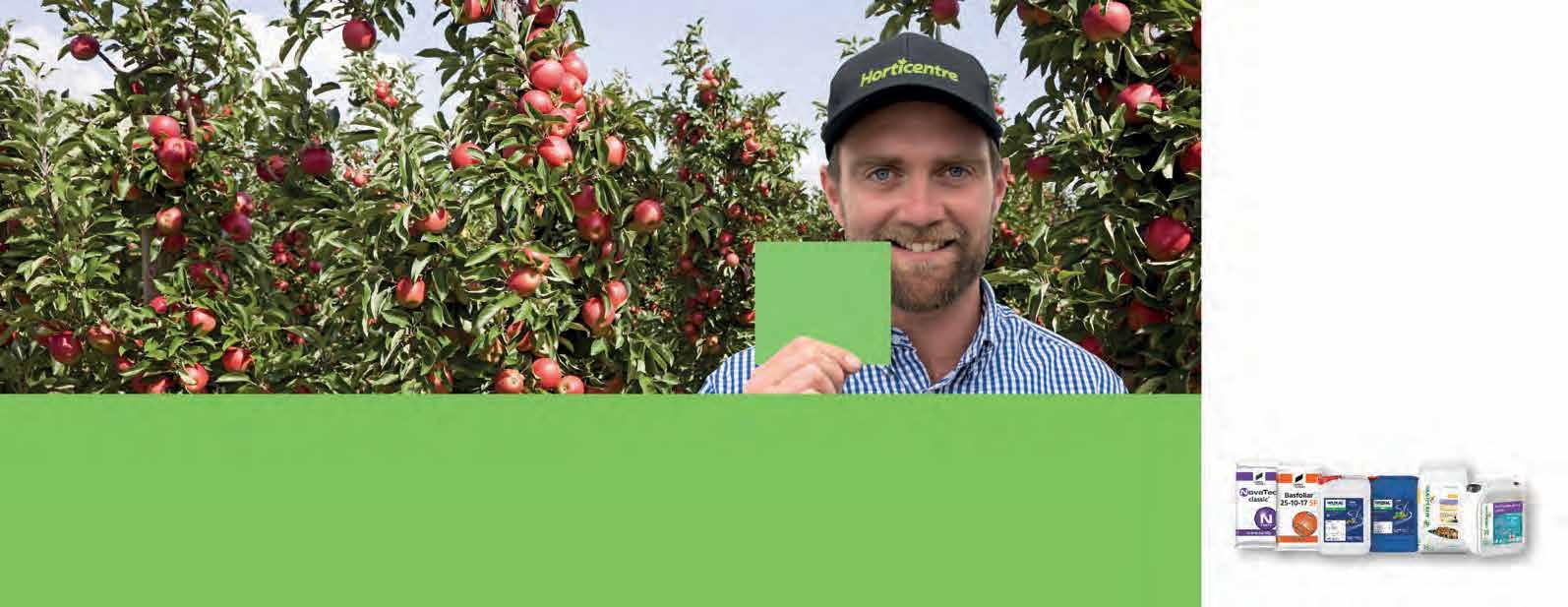
Nikesh Gurung and his Baygold team manage the 74-hectare Southland Orchard, near Paengaroa, producing the SunGold variety of kiwifruit.
He told Hort News they have improved their orchard practices, lead ing to better crop yield and plant health, with the help of MetWatch. This is an online tool that uses scientific-grade weather stations and pest and dis ease models to provide insight for decision sup port.
Gurung uses the tool “at least once a week” on his laptop or smart phone by logging onto the Kiwifruit Vine Health (KVH) Weather and Dis ease Portal, available to all kiwifruit growers.
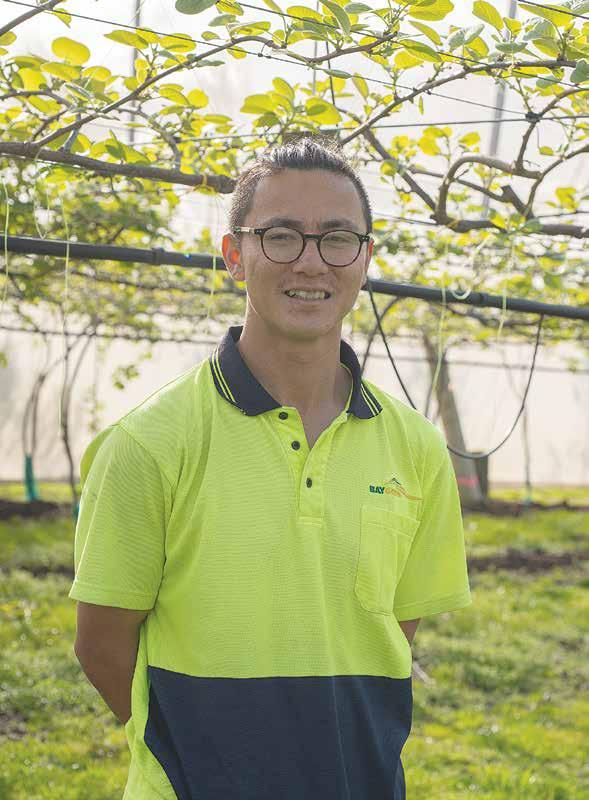
“There are multiple data types available [on MetWatch], including winter chill units, and all of it is crucial information for giving you an indica tion of what next season’s challenges will be and for planning around the use of coppers and anti biotics for management of diseases like Psa,” he explains.
“As the temperature rises and we approach summer we usually decrease the frequency or amount of [copper and antibiotics] applications, but if the Psa model in
MetWatch says there is an increased risk of the disease due to a weather event, it definitely helps to justify an extra appli
situated 15km inland from the Western Bay of Plenty coastline on soil rich in pumice-ash. The kiwifruit grown, as
market quality fruit. Having accurate weather data is criti cal, so Gurung worked with HortPlus – the com

system.
“I was really excited to be able to use our on-site weather station and link that into the MetWatch
MORE THAN JUST WEATHER
BAYGOLD ALSO harnesses the data in MetWatch to help demonstrate sustainability outcomes to local government.
It uses the technology to support any Justi fied Approval (JA) requests it makes to Zespri for the use of any non-standard products on their orchards, including for field trials.
Gurung says technology like MetWatch is the latest in a long line of technology innovations that have been driving the New Zealand industry forward since the 1990s.
“We’ve made huge progress as an industry in terms of how kiwifruit is grown and how it’s developed, and we’ve seen a whole lot of new varieties,” he told Hort News. “Having the right tools helps us to work smarter and make good decisions.”
MetWatch was first made available to the kiwifruit industry in 2016. Its platform has been deployed to a wide range of sectors, ranging from kiwifruit and onions to apples and arable crops, with different tools and crop-specific pest and disease models for each.
MetWatch is not only used by growers, but also by researchers and agronomists for more advanced modelling and data insight.
The platform is provided to all kiwifruit growers via the KVH Weather and Disease Portal. Growers in other industries may access MetWatch either through a corporate account or via online portals made available by their industry association, enabling industry-specific tools and models.
“It’s definitely adding value. The other day it rained for a long time but it was quite light. The weather station showed we’d only had 0.9mm on our orchard, but we’d all thought it was a lot more. The plants need 5 or 6mm to be really pro ductive on our land so we decided to irrigate – we might not have done that
in MetWatch is easy to interpret, regardless of technical ability, and reg ular email reports can be set up to make sure key information is sent directly to a user’s inbox.
“Everyone in our man agement team uses it,” he adds. “It helps us all stay aligned in our thinking and just having the tech nology gives us a fair idea

DECEMBER 2022 2 HORTNEWS
Sudesh Kissun sudeshk@ruralnews.co.nz
facebook.com/ruralnews
Nikesh Gurung says the MetWatch platform is giving his orchard the edge when it comes to weather forecasting and managing pests and diseases on his property.
Outdated perceptions of hort
peterb@ruralnews.co.nz

HISTORICAL NEGATIVE perceptions about horti culture seems to be a key reason why bright, young people are not signing up to do degrees that would take them into careers in the sector.
Massey Universities College of Agriculture and Environment head Profes sor Paul Kenyon told Hort News that the university is not getting the number of students through their doors that the industry is demanding in terms of potential jobs. He says it’s a struggle to get young people and their families to understand that there are real, high-value career opportunities in horti culture.
“This is because in the media they just see the low paying jobs – the pruning and picking –and don’t realise there are
professional opportuni ties in the industry and that is an issue.”

Kenyon says Massey has been doing much to try and attract the best and brightest to under take a hort degree that would see them end up in a well-paid, exciting and fulfilling career. He explains that Massey has

been trying to work with high school teachers –through the Horticultural and Agricultural Teach ers Association – as well as going to the schools and talking to potential
students and telling them about the opportunities there are in the sector.
“We are also trying to break down some of these historical perceptions, which has always been
that kids who are not so academically minded should do horticulture at school,” Kenyon adds.
“That is not what the industry wants. They want smart kids to realise
the opportunities in hor ticulture at high school and later do some tertiary education and then make horticulture their career choice.”
Kenyon says in all
degree courses – including horticulture – they have a range of papers which highlight the directions that stu dents can take in their future careers – things such as agritech, finance and food technology.
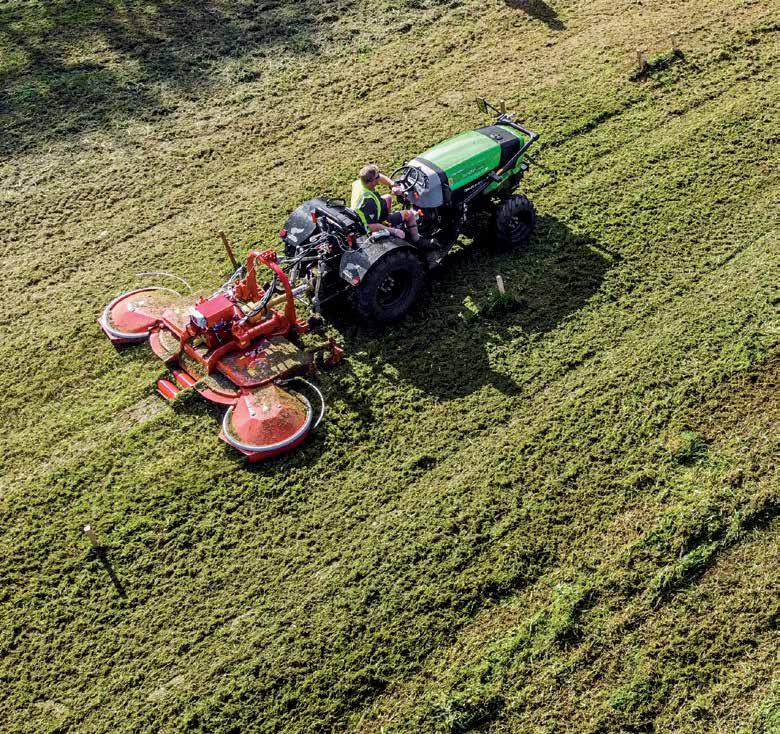
He adds that while it is a challenge to change perceptions with teach ers and parents, there has actually been an increase in the number of second ary schools teaching agri culture and horticulture.
“This has grown from a very small base from a handful of schools to almost 100 teaching it in some form,” Kenyon told Hort News

“We just need to get those kids that are doing this to progress their edu cation through to ter tiary level, so they can go on and make signifi cant impacts in the hor ticulture and agricultural industries.”
LV MULCHER/MOWER
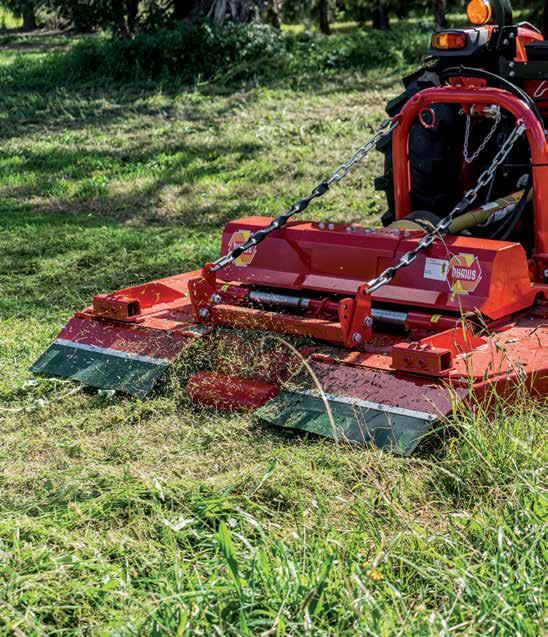
3 DECEMBER 2022 HORTNEWS
Massey
Peter Burke
“We are also trying to break down some of these historical perceptions, which has always been that kids who are not so academically minded should do horticulture at school.”
Paul Kenyon says it’s a struggle to get young people and their families to understand that there are real, highvalue career opportunities in horticulture.
The extremely compact & low design makes these mulching mowers a powerful & versatile partner in vineyards.
Compact design allows a small turning radius
Variable width that can be hydraulicly adjusted (LV180 model: 1.8-2.3m)
Wear resistant steel housing
Clean cutting pattern
YOU
more than 65 years Humus has been providing innovative mowing and mulching technology. New to Power Farming, these Mulcher/Mowers are perfect for Vineyards and Orchards.
manufactures and installs
majority of its components
meaning they
high quality machines that you
last. Power Farming NZ | www.powerfarming.co.nz | 0800 627 2225
•
•
•
•
QUALITY
CAN TRUST For
Humus
the
inhouse,
are
can trust to
Biosecurity a big risk for the bee sector
Burke peterb@ruralnews.co.nz
A DOWNTURN in the honey market has the potential to cause a major biosecu rity issue for the NZ bee industry.
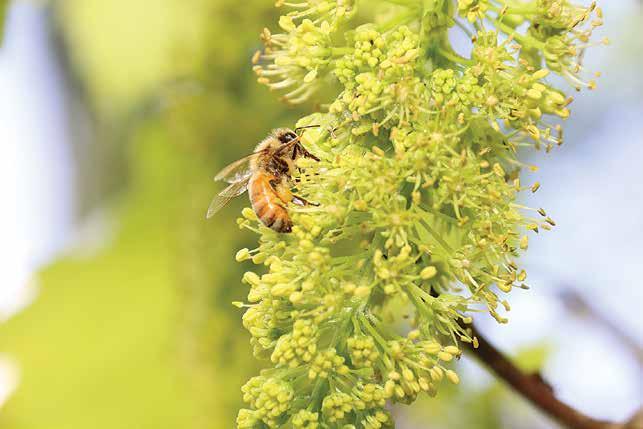
ApicultureNZ (APINZ) chair Nathan Guy says with industry still facing hard times, some beekeepers are simply aban doning their hives in the bush.
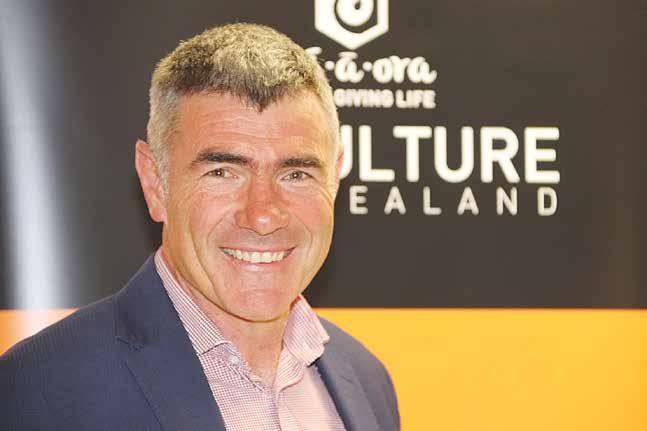
With no control over these bees, Guy says many industry people are con cerned that there could be an outbreak of varroa mite, American Foulbrood or –worse still – Tropilaelaps mites (see box).
The latter is not in NZ or Australia but is present in Asia and with the lack of control of hives an outbreak could take
“I always thought honey could last for quite a long time, but in fact the properties change over one to two years, so there is quite a bit of blending going on with honey to get it into certain markets. With the change in properties comes a change in quality and the subsequent lower price after a few years.”
place without anyone knowing until the disease takes hold.
About 10,000 people are involved in beekeeping in NZ, but Guy points out that around 7,000 of these have seven hives or less and are effectively hob byists. This is the problem for APINZ, which is a voluntary membership organ isation with about 2,500 members.
Some years ago, the honey industry rejected a proposal for a compulsory levy like DairyNZ and HortNZ. This means that while APINZ represents all those in the industry, only about a quarter of bee keepers pay for its existence.
“It would be great over time if more people joined APINZ, which is really the one-stop-shop for industry and has very strong relationships with govern ment and – especially MPI and NZTE,” he told Hort News. “We provide great advocacy and information flows back to beekeepers.”
Guy says, along with biosecurity, the other big challenge for the honey indus try is the lack of markets for honey. He says this dates back to 2020 when there was a bumper crop and then Covid hit, which created some major compli cations. He says there is quite a bit of honey stockpiled in factories and sheds
still waiting to find a market.
“I always thought honey could last for quite a long time, but in fact the prop erties change over one to two years, so there is quite a bit of blending going on with honey to get it into certain mar kets,” he explains. “With the change in properties comes a change in quality and the subsequent lower price after a few years.”
The slump in honey prices has seen a drop in the number of hives in the indus try. Guy says these once numbered over a million but are now down to around 700,000. He says that’s not necessar ily a bad thing because there is still the opportunity to produce the same amount of honey with fewer hives.
“But I think for a lot of honey pro ducers it’s a challenge getting the prod uct to market.”
BIG RISK
as well as reproduce on honey bee brood. ❱
Tropilaelaps mite infestation causes severe damage to honey bee colonies, such as deformed pupae and adults (stunting, damaged wings/legs/abdomens), parasitic mite syndrome (PMS) and colony decline. The colony may also swarm or abscond, further spreading the mite to new locations. Tropilaelaps mites can also spread viruses, which further affect the colony’s health and disease susceptibility.
LOOKING FORWARD
For a number of years now, APINZ has been trying to get on top of the industry’s problems and is in the process of completing a strategic plan to map the way forward.
Guy says the recent Free Trade Agreements (FTAs) with Britain and the European Union, which will see the tariffs on honey lifted, will open up new opportuni ties. However, he warns that the industry has to be very focused on the big picture.
“The industry has got to be careful that it continues to add value to product and not commodity and bulk,” Guy told Hort News. “It must have a fair line of sight as to what the customer and consumer wants, so therein lies a challenge and it’s easy to talk about, but quite hard to deliver.”
With the pressure on the honey industry, many beekeepers are moving into the pollina tion business. Guy says pollination for agricul ture and horticulture each year generates about $7 billion.
“But pollination is quite hard on the bees, especially if they are under nets, because their wings get beaten up,” he explains.
“It is not easy for a bee to do pollination. In fact it’s quite hard on them. But it is a very important service that is provided and not one that is well understood. I think there is an oppor tunity to raise aware ness about it.”
Meanwhile, Guy says it’s very impor tant for the industry and government to be vigi lant on the issue of bios ecurity.
“The industry has to focus on beekeepers and the Government on protecting the border.”
DECEMBER 2022 4 HORTNEWS
Peter
❱ Tropilaelaps mites are native
and naturally
the brood
the Giant honey
Apis
❱ Two
are
Tropilaelaps
to Asia
parasitise
of
bees of Asia, such as
dorsata
species of Tropilaelaps mites (T. clareae and T. mercedesae)
also able to parasitise European honey bees ( Apis mellifera).
mites are external parasitic mites that feed on the haemolymph (blood) of drone and worker bee pupae,
ApicultureNZ chair Nathan Guy says with industry still facing hard times, some beekeepers are simply abandoning their hives in the bush and this poses biosecurity risks.
Poor quality erodes profits

POOR FRUIT quality is shaving millions of dollars in profit off major New Zealand exporters this season.
One of NZ’s biggest apple exporters, T&G Global, is now forecasting a loss for the 2022 finan cial year, partly caused by the poor quality of NZ apples.
T&G Global is blaming apple quality and worsen ing economic conditions in Europe and the UK, where it has operations
number of projected oneoff items, including prop erty disposal and the costs of exiting the com pany’s Peru grape farming operation,” it says.
For the kiwifruit sector, the story is the same.
Major exporter Seeka says that following a challenging kiwifruit season in New Zealand, it now expects to post a net profit before tax of between $6.5m and $9m. This is a downgrade from the previous market guid ance range between $9m and $11m.
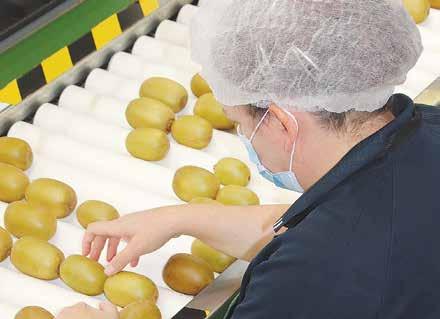
Bay,” says Meikle. “Nelson also experienced unsea sonably high rainfall in the late winter and early spring.”

He adds that growers will be hoping for more settled weather in the
coming months and also the prospect of a close to full seasonal labour work force.
“These two elements will help to ensure the harvest brings improved returns.”
INSECT
for its profit downgrade.
The company, owned by German conglomerate BayWa Ag, is now fore casting a loss of between $1m and $5m for the financial year – compared to $9.8m gross profit last year.
In a statement to the NZX, the company says there has been a rapid deterioration in the qual ity of T&G’s premium New Zealand Envy apples, particularly those apples exposed to the unusually heavy rains during the 2022 harvest.
“This, combined with the late arrival of fruit into markets as a result of global supply chain dis ruptions, has unfortu nately resulted in crop quality issues, with fruit rapidly deteriorating and consumers having an inconsistent eating expe rience,” the company explained.
“As a result, inventories are higher at this stage of the year than normal, resulting in provisioning for fruit losses as the fruit ages.”
T&G Global says its operations in Europe and the UK have reduced their forecasts due to worsen ing economic conditions in their respective mar kets.
“This forecast also includes the impact of a

Seeka says the reduc tion in earnings reflects a later shipping season, challenging fruit quality across the industry and expected reduced fruit earnings from the global market.
New Zealand Apples and Pears Incorporated (NZAPI) reports that export volumes are below mid-season forecasts.
Chief executive Terry Meikle says exports were negatively affected by “a perfect storm of unfa vourable weather condi tions during the growing season, labour shortages, weak demand, inflation hitting consumer spend ing, shipping and logis tics issues and reduced demand from European and UK markets”.
Labour shortages and weather events impacted fruit quality, Meikle told Hort News
He warns that a reduc tion in export volumes, together with significantly increased production and post-harvest costs will have seriously impacted the profitability of most New Zealand apple and pear growers in 2022.
Next year’s harvest could also be affected.
“It is still too early to ascertain the impact on next year’s harvest of one of the wettest springs on record in the Hawke’s
For
The smarter choice for integrated pest management for potatoes and other vegetable crops.

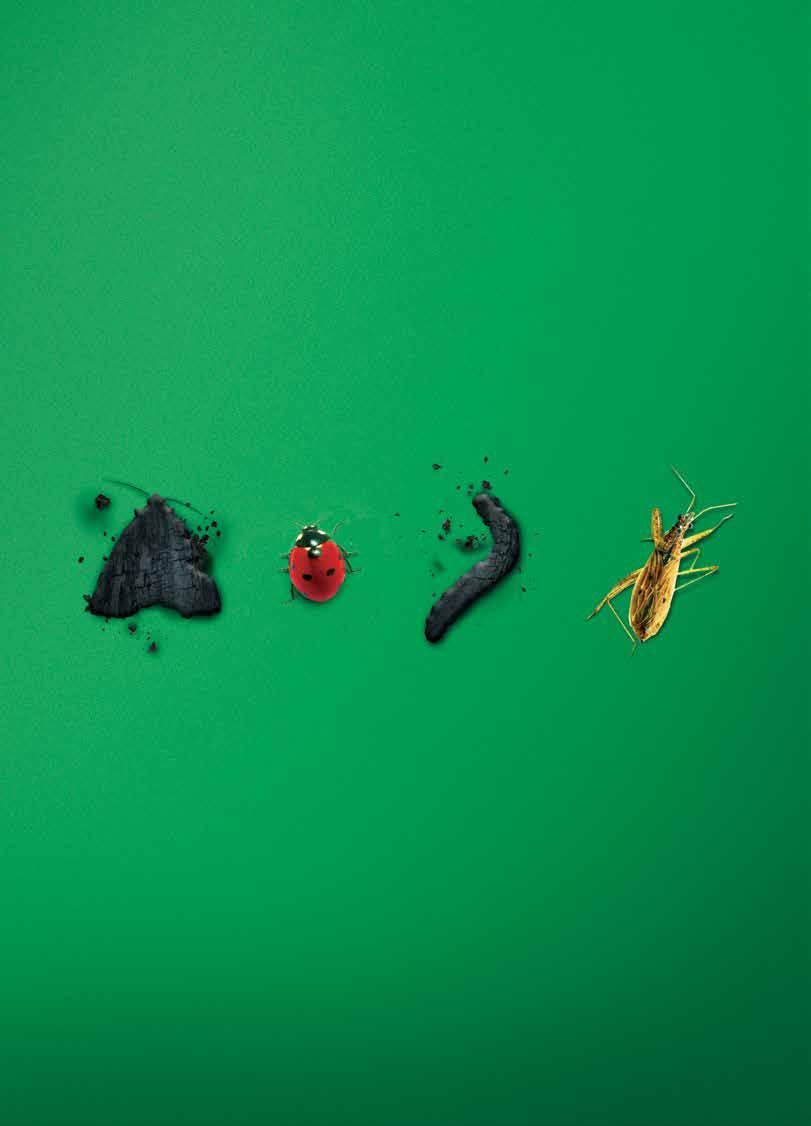
5 DECEMBER 2022 HORTNEWS
Sudesh Kissun sudeshk@ruralnews.co.nz
Poor quality fruit is leading to lower profits for NZ exporters this season.
“As a result, inventories are higher at this stage of the year than normal, resulting in provisioning for fruit losses as the fruit ages.”
www.fmccrop.nz
more information:
Apple grower wins title
HAWKE’S BAY apple grower Regan Judd has won the title of Young Horticulturist of the Year.
Judd was up against six other finalists repre senting different sectors within the horticulture industry and represented the Young Grower of the Year (Horticulture New Zealand Fruit & Vegeta ble Sectors). He currently works as an orchard sector manager with T&G Global in Hawkes Bay.
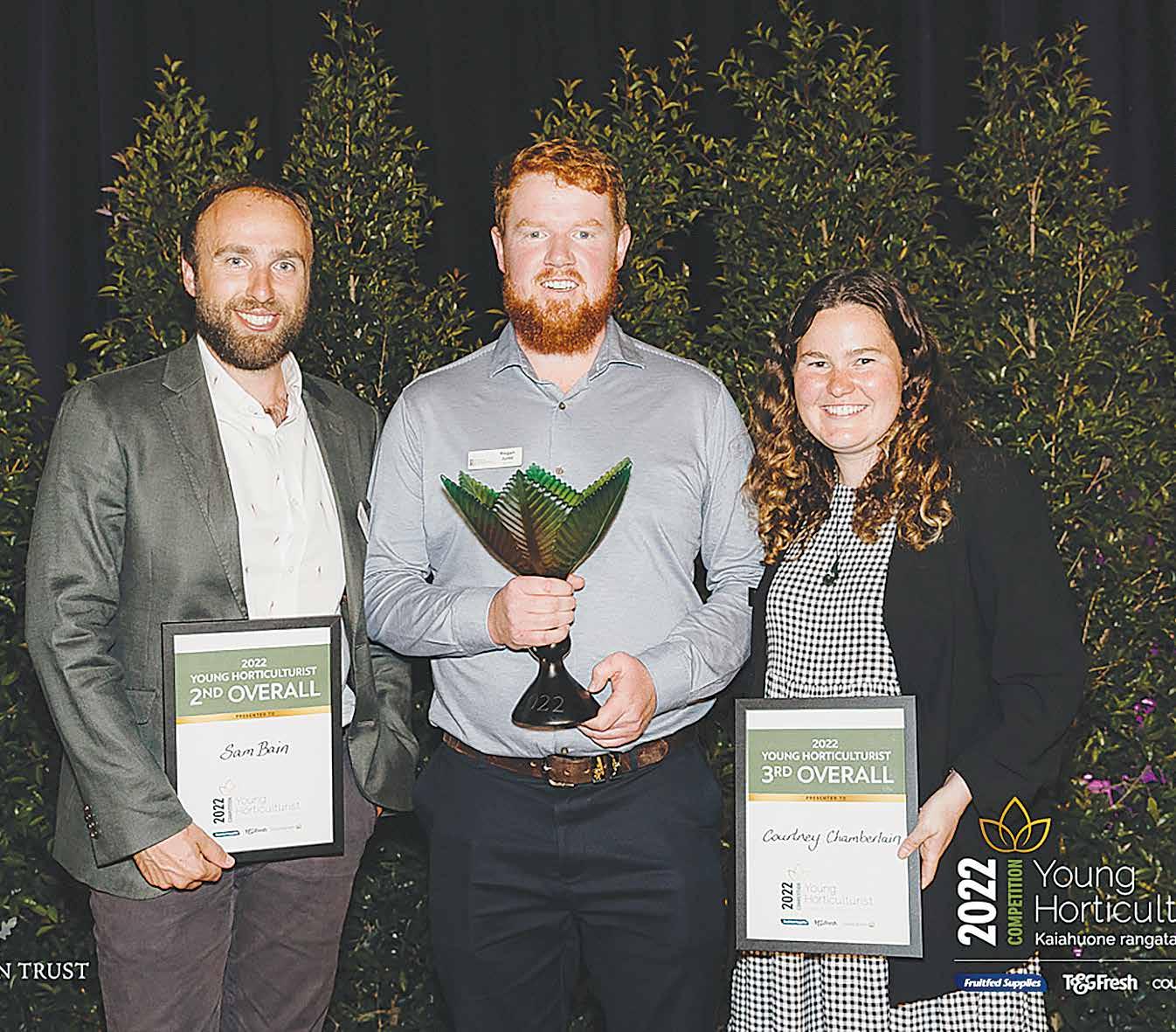
The 26 year-old has been with T&G Global –a grower, distributor – for five years. He joined the company when he moved to Napier, after graduat ing from Massey Univer sity with a Bachelor of Agriscience majoring in horticulture.
Sam Bain, a vineyard manager employed by Villa Maria Estates in the Hawkes Bay, came second. Meanwhile, Courtney Chamberlain – who is the assistant manager of Had stock Farm, near Christ church – came third.
The competition is now in its 17th year and the seven competing sec tors were: Young Ame nity Horticulturist (New Zealand Recreation Asso ciation); Young Achiever (New Zealand Plant Pro ducers incorporated);
Young Florist/Flower Grower (FLONZI Flo rists and Flower Growers NZ Incorporated); Young Landscaper of the Year (Registered Master Land scapers New Zealand);
Young Viticulturist of the Year (NZ Winegrowers); and Young Grower of the Year (Horticulture New Zealand Fruit & Vegetable Sectors).
The seven compet itors were selected as finalists after competi
tion placings within their own industries. Finalists were judged across sev eral challenges including practical skills, industry expertise, leadership abil ity, business knowledge and communication.
Young Horticultur ist chairperson Hamish Gates says the Young Hor ticulturist of the Year
event offers an oppor tunity like no other for emerging leaders to chal lenge themselves and refine their skills.
“The confidence final ists gain within our event sets them up to take on bigger challenges in their daily lives. We strive for one thing – to seed the future now,” he says.
During the finals, com petitors were involved in leadership interviews, were asked to present their views on sustain ability, tackled an innova tion project, prepared and presented a speech, and were challenged on vari ous practical skills.
Judd’s first prize includes a $7,500 Travel,
Accommodation and Professional Develop ment Package. The first prize also includes $1,250 ICL Fertilisers vouch ers, a one-year member ship of The New Zealand Institute of Agricultural & Horticultural Science (NZIAHS) and a selec tion of Aorangi Merchant products.
Judd encourages other young people to strive to compete in the Young Horticulturist Competi tion.
“It’s opened my eyes to the vast opportunities in our sector and has helped me gain the confidence in myself to take further leaps.”
Gates says the
HORT RESEARCH COMPANY LIQUIDATION
TAURANGA-BASED plant research facility PlantTech Research Institute has gone into liquidation.
The facility operated as a research and development organisation spe cialising in addressing scientific chal lenges in New Zealand’s horticulture industry, providing artificial intelli gence technology solutions.
However, chair Mark Gilbert says the company’s sole shareholder PlantTech Research Institute Incor porated had decided to put it into
liquidation, which he described as a “perfect storm”. Gilbert says the com pany’s pipeline of revenue dried up, with its clients, mostly in the horti culture sector, facing “very tough” seasonal and broader economic con ditions.
“The kiwifruit and apple sectors in particular are facing their worst season in 10 years, and this is seri ously impacting on their ability to invest in innovation currently,” he says.
Meanwhile, PlantTech’s five-year establishment funding from the Ministry of Business, Innovation and Employment (MBIE) is coming to an end. The company has claimed a total of $129,000 from four separate Callaghan Innovation grants since 2019.
Gilbert says, combined with the downturn in commercial revenue, the business was unable to survive with out further government support and it had been told none was available.
“The board had therefore decided it had no option other than to make the decision to appoint liquidators while the company remained sol vent.”
Gilbert claims that by making the decision now, the business should be able to pay full entitlements due to staff and creditors.
“The board’s view is that continu ing the business from here would risk trading the company into insol vency.”
Young Horticulturalist competition is important for horticulture in New Zealand and couldn’t occur without the support of official partners –T&G Fresh, Countdown, and Fruitfed Supplies – as well as the friends and supporters of the competition such as Hort News
Despite the company being wound up, Gilbert believes it did some fan tastic work, which could create “very significant economic benefits” to New Zealand.
“We hope that much of this work can be continued in future by others, however, it is no longer viable to do so under PlantTech as it currently stands.”
Steven Khov and Kieran Jones, of Khov Jones, had been appointed liq uidators.
DECEMBER 2022 6 HORTNEWS
Young Horticulturist of the Year finalists Sam Bain (left), Regan Judd (winner) and Courtney Chamberlain. PHOTO/SUPPLIED.
Blueberries still available for Xmas
THE BLUEBERRY industry is reassur ing New Zealanders that the popular fruit will still be available this Christ mas.
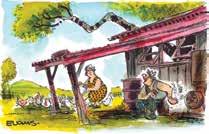
This is despite the season getting off to a rough start with October’s hard frost (-4.8 degrees c).
Blueberries New Zealand exec utive member Jeremy Wylie says despite recent frosts wiping out entire orchards in the Waikato, there will be enough stock for the Christmas holi day season.
“We know the demand for Blue
berries is high, as data over the last few years has shown massive buyer growth for our fruit,” Wylie explains.
“It is one of our most challeng ing years, but we are very keen to ensure New Zealanders get to enjoy our healthy, delicious fruit this year.”
He says there’s been a massive upswing in consumption for blueber ries – particularly since the pandemic, as people are looking for the healthi est fruit and vegetables available.
“Blueberries are the perfect little snack, full of dietary fibre, vitamin C,
vitamin K, manganese, and vital anti oxidants,” Wylie says.
The blueberry season is tradition ally from October to April.
NZ cricket captain goes into bat for little apple company
Kane Williamson is extending his relation ship with niche NZ-based apple company Rockit.

Following his 18 months as global ambas sador for the company, Williamson, is adding to his investment portfolio by taking a stake in the Longlands Rockit apple site just south of Hast ings.
He is also extending his global ambassador ship for a further year.

“I really believe that Rockit apples are a fantastic product, so to be involved in growing the brand and sharing this Kiwi success story with the world is really exciting,” Williamson says.
This news is on the back of the company taking out the Supreme Award at the New Zea land International Busi ness Awards in October.
first
says. “Kane’s spent time with us in Hawke’s Bay, learning first-hand about the innovation we’re rolling out across our orchards, and into our packhouse.”
And now Williams has skin in the game.
“I love what Rockit has done with its world leading brand, along with the technology that goes into growing each apple –from geo-mapping trees so that correct nutrients are delivered at the right time, to the robotics in the packhouse.”
Williamson adds that he has enjoyed participat ing in digital marketing campaigns for the global miniature apple brand, and even shared cartons of his favourite fruit with teammates during man dated Covid-19 isolation.
“When you spend a lot of time in hotel rooms and quarantine bubbles there’s nothing better
than a super healthy, super tasty snack to get stuck into.
“The boys pretty much expect me to turn up with apples for everyone these days!”
During 2022-2023, Williamson will continue to support Rockit’s efforts in cricket loving nations, Asia and the Middle East, through omni-channel campaigns driving sales, social media growth and brand awareness.
Rockit general man ager global market ing Julian Smith says it’s exciting to share the news that Williamson is on board as both investor and ambassador.
“Of course, many of our growers, our board and our global team are cricket mad. So having Kane on board with Rockit is a real delight for them too, and we’re all very proud of the associ ation.”
7 DECEMBER 2022 HORTNEWS
BLACKCAPS CAPTAIN
Rockit Global Lim ited chief executive Mark O’Donnell says William son’s support has already
helped Rockit make inroads into the lucrative Indian and subcontinen tal market. But more than
that, he says it’s the NZ cricket captain’s attitude that has impressed.
“From the moment we
met with Kane, it was clear his ambassadorship meant more to him than an emblem on a bat,” he
Williamson’s support has already helped Rockit make in-roads into the lucrative Indian and subcontinental market.
Chief executive Mark O’Donnell says
2023 Edna Calendar T: 09-307 0399 then press 1 to be put through to reception E: julieb@ruralnews.co.nz ORDER NOW! ❱❱ $25 including post & packaging ❱❱ 12 of Edna’s best cartoons ❱❱ 330mm x 240mm, spiral bound EDNA!! EDNA CALENDAR 2023 “You do realise Edna, if we start to float, you’ll be breaking the law banning live animal shipments!” “Break my New Year resolution? no way – it must be the Aussie bushfires you can smell!” RURAL NEWS ALL FOR FARMERS HORTNEWS SUNDAY MONDAY TUESDAY WEDNESDAY THURSDAY FRIDAY SATURDAY 1 2 3 4 5 6 7 8 9 10 11 12 13 14 15 16 17 18 19 20 21 22 23 24 25 26 27 28 29 30 31 1 2 3 4 JANUARY FEBRUARY NEW YEARS ANNIVERSARY ANNIVERSARY
@rural_news facebook.com/ruralnews
Public campaign targets greater awarness of stink bugs
NASTY BUGGERS
BIOSECURITY NEW Zea land is ramping up a public awareness cam paign to encourage people to report possible sight ings of the brown marmo rated stink bug (BMSB).
The insect feeds on over 300 species – includ ing significant crops such as apples, corn, wine grapes, kiwifruit, and a range of stone fruit variet ies causing severe damage to flowers, stems, leaves and fruit of host plants.
Although not yet established in New Zea land, stink bugs present a major threat to New Zea land’s horticulture indus try. In the United States, the first reported sighting was in Pennsylvania in 2001 and in just 20 years they are now found in 46 states. The bugs have been known to cause mil lions of dollars in crop damage, sometimes with upwards of 90% of crop being rendered unsale able.
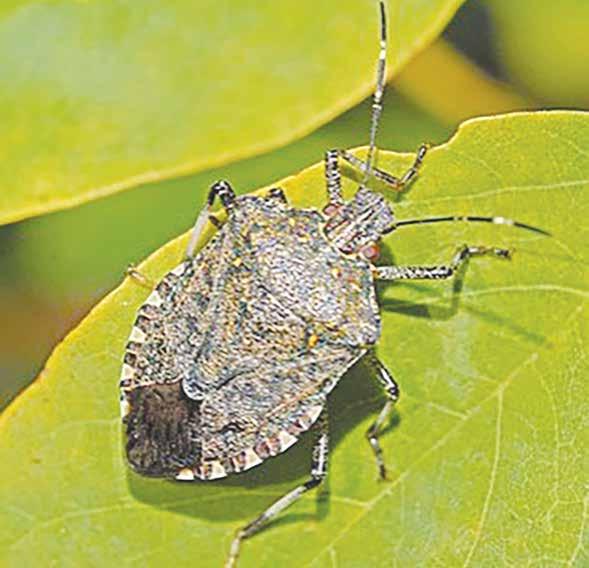
Jointly funded by Bios ecurity New Zealand and industry members of the BMSB Council, the summer campaign will run from November to
March, targeting local gar deners and online shop pers who receive goods from overseas.
“There is ongoing monitoring of the threat
posed by countries that have known BMSB pop ulations,” says Biosecu rity New Zealand deputy director-general Stuart Anderson.
“Officers target pas sengers, craft and goods that could be contami nated with BMSB. Moni toring of countries with known BMSB populations and targeting of passen gers and goods have been effective to date, with no evidence of any estab lished BMSB population in New Zealand.”
A Biosecurity New Zealand quarantine offi cer detected a single live BMSB at an airport search
bench on 8 October while processing passengers arriving from the United States. A second bug was found on an 18 October flight from South Korea prior to passengers leav ing the plane, with offi cers detecting a further 286 dead BMSB on arriv ing vessels and cargo.
Biosecurity New Zea land says the number of live interceptions has dropped considerably over the last few years.
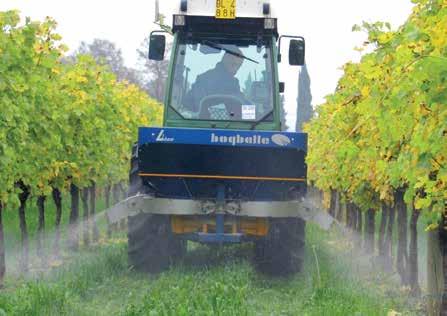
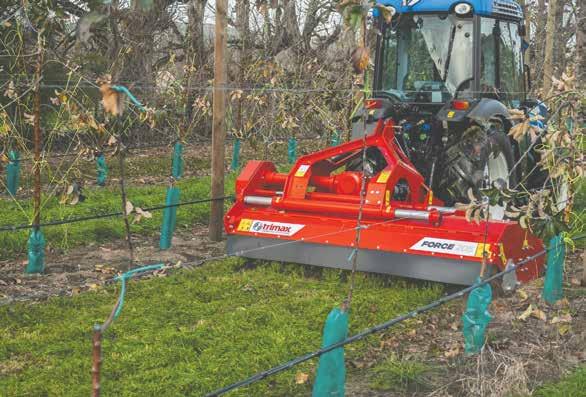
APPROXIMATELY 1.7CM long and forming a distinctive shield shape (leading to their alternate name of shield bugs), stinkbugs use their piercing mouthparts to pierce through the outer skin of fruit and consume the flesh within.
A combination of the inner flesh exposure to air and germs in the stinkbugs cause the flesh around the bite area to rot and decay rendering the fruit unfit for human consumption.
BMSB lay 28 (on average) small, light green eggs per brood on the underside of leaves with an incubation period of 3-5 days. Tests carried out in the US in which stinkbugs were tethered to a freely rotating measuring device have shown that stinkbugs are capable of flying up to 5km per day. Although precise details are difficult to ascertain, depending on climate BMSB have been known to produce multiple generations per year.
It believes this is largely due to the introduction of strict import rules that make it harder for live BMSB to enter New Zea land on risky cargo such as vehicles, machinery and parts.
Improved reporting and monitoring has also allowed officers to better target risk goods, with a greater focus on air cargo during the 2021/22 season following increased BMSB detections in this path way.
Anderson says that Biosecurity New Zealand has seen high levels of engagement from the shipping industry in the past and wants this positive relationship to
continue.
“Accurate reporting of detections by crew helps Biosecurity New Zealand target its surveillance and other actions. We ask international travellers to be understanding of the need to protect New Zealand and our econ omy as they get their bags checked or are required to answer questions from our frontline staff.”
Anyone who thinks they’ve found BMSB are asked to catch it, take a photo and report it. The find can be reported online (https:// report.mpi.govt.nz/pest/) or via Biosecurity New Zealand’s hotline (0800 80 99 66)
DECEMBER 2022 8 HORTNEWS
Leo Argent
Stink bugs present a major threat to New Zealand’s horticulture industry.
For more information or to find your nearest Origin Ag dealer go to
Precision twin spinner fertilizer spreader with or without two row side dresser units.
The magic in mushrooms!
IT WAS mushrooms pop ping up on the lawn during the Covid-19 lockdowns that led Colin Cambier of Wainui, north of Auck land, to what he hopes will become a thriving business in exotic culinary mush rooms.
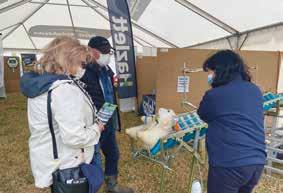
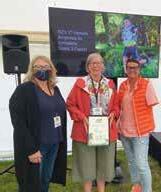
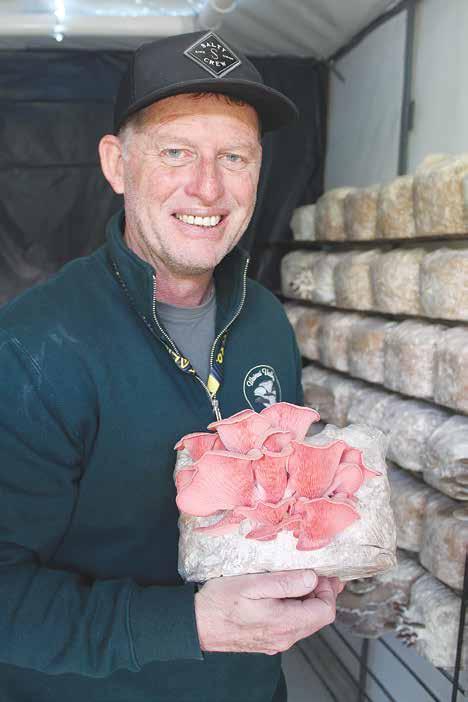
The long-time salesman is “still building his brand” of Wainui Valley Mush rooms and knows that mar keting will be the key to the success of his venture.
Cambier says while popular and well-known in Asian cuisine there is still much work to do in educating the Western palate on the delicate texture and mild, savoury flavour of oyster mushrooms.
While he and wife Bron wen both work off farm, Colin also does up to 30 hours a week on the mush rooms and Bronwen helps with sales.

So far, sales have mainly been through farmers mar kets, a speciality grocery store and food outlets.
However, Cambier believes the potential is huge. A Raglan grower, he corre sponds, with started in similar way and now has a thriving half-million dollar business.
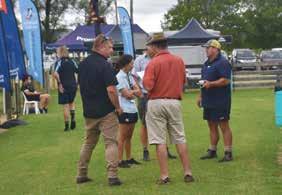
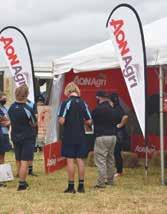
One of the reasons Cambier selected oyster mushrooms was because of their culinary value and perceived health benefits.
“It is a big Asian thing, the Chinese have eaten those mushrooms for thou sands of years for a partic ular reason,” he told Hort News
Oyster mushrooms are claimed to be beneficial to the blood. Meanwhile, another type of mushroom Cambier grows, Lion’s
Mane, is perceived as ben eficial to the brain.
He says there has been a lot of research in the Asian world on the perceived benefits of mushrooms. While some Western research supports this, it is only a small body of research so far.
Cambier grows grey and pink oyster mush rooms and has recently started growing native oyster mushrooms. He gets
native spores from Raglan and two varieties from a Northland supplier. Pink and grey oysters are a fan shaped and the native oys ters are more of a trumpet shape. Lion’s Mane looks more like coral.
“The oysters are the easiest of the fancy mush rooms to grow. From start to finish takes 15 days with three or four processes involved,” he explains. “I do want to change up and
bring some others in and with mushrooms there are so many possibilities. Turkey Tail also has a rep utation for major health benefits.”
This is not a great eating mushroom but it can be ground up and mixed with things like Lion’s Mane in a capsule and Cambier says people spend a fortune on it. About 90g of ground Lion’s Mane can sell for $70.
RESTAURANTS TOUGH MARKET TO CRACK
Cambier is certified to grow mushrooms but further qualifications are needed for dehydrating and other processing.
This may be further down the track for him. First he is focusing on his marketing with his upmarket looking packaging and point of sale material, social media and website.


He aims for quality and value for money and to create a business for his retirement. He doesn’t want to chase the big supermarkets because as a “mushroom nut” he wants to maintain the integrity of his product which has a short shelf life.
Cambier wants to aim at the more exclusive fresh produce and grocery stories or into restaurants. However, despite some interest, he hasn’t cracked it with restaurants yet.
“Where I am doing quite well is these little pop-up kitchens, little coffee shops and stuff like that that make toasties,” he told Hort News
“I work with an amazing young lady who also employs her sister and they get up at 4am and sit on the roadside at Waitoki with a container called Mini Oak. They catch logging trucks at 4.30am with coffees and food; she has a commercial grade kitchen at home. At 5.30am she catches all the tradies off to work and at 7.30am she catches the mums dropping their kids off at school. She has a thriving little business and good on her.”
Food outlets which do things like toasties, quiches and baked goods are perfect for his product where the mushrooms are the star of the show.
He believes his mushrooms could well catch on with restau rants as they are perfect for experimentation for budding chefs. It is something different to what they would find on supermarket shelves.
To make his website more interactive he wants to start encour aging people to send in recipes and perhaps have a competition. One of his regular customers uses them in Miso soup.
Cambier says he is all about community and wants his local producers to work together. In Weranui Rd for instance there is a free range egg farm, a deer farm, an organic dairy from, an olive oil producer, a tea tree oil producer and a bush trails outfit to name a few.
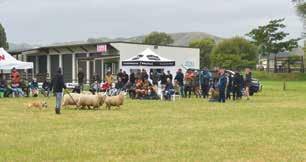
As a start, a group of small business owners are getting together on the last Friday of every month to share ideas and resources.
Home grow kits are another side-line to his business. He is sticking to the oyster mushrooms because they only take 15 days –the grey, the pink and the native oysters.
“I’ve had a lot of inquiries for Christmas – it’s an unusual gift for those who have everything. It doesn’t take much work at all.”
The mushroom waste makes “fantastic” compost and he is booked three months in advance for that.
9 DECEMBER 2022 HORTNEWS
Pam Tipa
22-23 February 2023 Wairoa A&P Showgrounds eastcoastexpo.co.nz Two days of exhibits, demonstrations & seminars for East Coast sheep & beef farmers East Coast Farming Expo Connecting East Coast Farmers
Wainui-based mushroom grower Colin Cambier with pink oyster mushrooms.
KBC’s goal of fast tracking new kiwifruit cultivars
'More, better and faster' is the ethos of the relatively new Kiwifruit Breeding Centre (KBC). Peter Burke was in Te Puke recently, where he spoke with Dr Bart Challis, KBC's chief commercial officer.
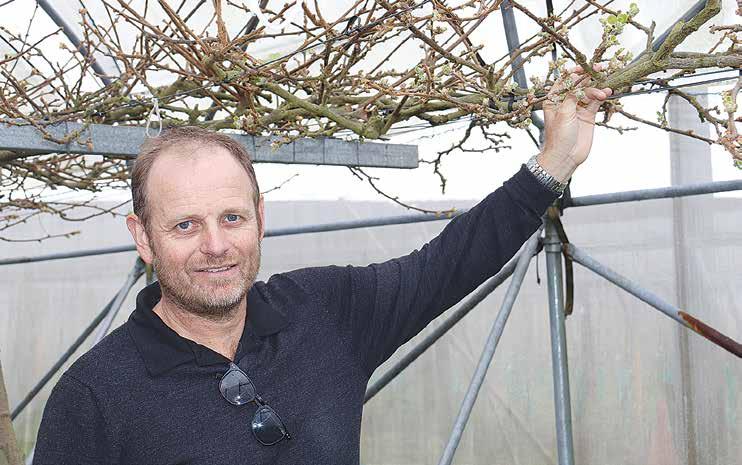
THE NEW organisation was established just over a year ago and is a 50/50 joint venture between Zespri and Plant & Food Research Institute (PFRI).
Its headquarters are in Te Puke, but also has staff located in Kerikeri, Motueka, Auckland and selected kiwifruit regions globally. The aim of the new centre is to take the existing 30-year relation ship of successful kiwi fruit breeding between Zespri and PFRI to the next level.
Dr Bart Challis, KBC’s chief commercial officer, says the breeding programme that’s existed in the past has been really successful with the development of Hort 16A SunGold and Ruby Red.
He says the intention of the new joint venture is to build on this and give a much deeper integration for both partners.
Challis explains that the previous model was in part a transactional one and at arm’s length, whereas KBC brings together the organisations at a more strategic setting.
“It’s about enabling KBC to get the best out of the CRI ecosystem, whilst not necessarily being constrained by the bigger mission that CRIs have such as PFRI,” he told Hort News. “Whereas having a dedicated lead ership team and focused solely on a kiwifruit and the breeding programme
I think is at the heart of what we are trying to achieve here.”
Challis says the goal is to produce more and better cultivars faster. He says this sits over the top of a mission state ment, which is to produce kiwifruit that suits the demands of consumers, growers and the supply chain.
“The ‘more’ is not simply a volume based measure in isolation,” he explains.
“It’s really about increasing our success in delivering on the market concepts and in turn pro viding the industry with increased commercial opportunity.
“In terms of the market concepts, Zespri gives us world-leading market insights and tar gets in that space, which could be an eating experi ence or something health related.”
Challis says the goal of KBC is to deliver solu tions through technology, rather than technology delivering solutions. To
that end, the KBC team is looking to tools in par ticular genomics aimed at speeding up the process of finding new suitable
According to Challis, this may not necessarily shorten the timeframe from initial research to commercialisa tion.
However, he says the options the new technology offers will be better ones.
Challis adds that the benefits of tools like genomics have been proven globally and that is an area where some of the fundamental research being done by PFRI comes into play.
“Characterising what constitutes a unique genetic trait is not straightforward, so the scientific capability provided by PFRI is hugely powerful. In addition, there is
cultivars and special valu able traits within these.
“That means if you have a particular attribute that you want, you can


also a strong focus on digital and the translation of data into predictions,” he explains.
“If you can get to a predic tion which says, if you do A and B and we will get C and D, or whatever, as the outcome, that will accelerate your breeding programme and shorten the journey.”
Challis says, in the past, the focus has been somewhat on the ‘better’, which was the novel cultivars such as red, but the goal of KBC is now to see how they can change the trajectory and place more emphasis on developing these faster.
Challis himself has
use genomics to screen a population and iden tify the individuals that have what we are look ing for, and by having the
come to KBC from a series of successful roles in the biotechnology, technology transfer, life sciences, genomics and business devel opment areas. He describes himself as a scientist with a background in commerciali sation and innovation.
Fellow members of KBC’s leadership team are expe rienced operators in the sector, many coming from Zespri and PFR, and all have a single focus on speeding up and improving the kiwifruit breeding programme.
Although not at liberty to talk about specifics, Challis says the pipeline of cultivar
confidence that those attributes are well rep resented, it is effectively the equivalent of buying a better lotto ticket.”
concepts has been developed over a long period.
“It represents a huge asset when it comes to dealing with emerging risks such as climate change, as well as continuing to expand kiwi fruit’s profile within the global food bowl.”
Finally, Challis says when you look around the world at great examples of globalleading fruit brands, they all have a strong focus on tech nical innovation within their breeding programmes, brand and quality. With the invest ment of both Zespri and PFR, NZ finds itself in a similar world-leading position.
DECEMBER 2022 10 HORTNEWS
BENEFITS OF GENOMICS 2023 Edna Calendar T: 09-307 0399 then press 1 to be put through to reception E: julieb@ruralnews.co.nz ORDER NOW! ❱❱ $25 including post & packaging ❱❱ 12 of Edna’s best cartoons ❱❱ 330mm x 240mm, spiral bound EDNA!! EDNA CALENDAR 2023 “You do realise Edna, if we start to float, you’ll be breaking the law banning live animal shipments!” “Break my New Year resolution? no way must be the Aussie bushfires you can smell!” RURAL NEWSFARMERS HORTNEWS SUNDAY MONDAY WEDNESDAY THURSDAY FRIDAY SATURDAY 1 2 3 4 5 6 7 8 9 10 11 12 13 14 15 16 17 18 19 20 21 22 23 24 25 26 27 28 29 30 31 1 2 3 4 JANUARY FEBRUARY ANNIVERSARY “In terms of the market concepts, Zespri gives us world-leading market insights and targets in that space, which could be an eating experience or something health related.”
KBC chief commercial officer Bart Challis says the aim of the JV is to take the past kiwifruit breeding successes between Zespri and PFRI to the next level.
NZ macadamias more healthy
MACADAMIA NUTS grown in New Zealand may be an option for those looking at a health ier diet.

Preliminary analysis of Torere Macadamias nuts, grown in the Eastern Bay of Plenty, have shown they have promising con centrations of three key nutrients – vitamin C, vitamin B6 and selenium. This was more than com parative macadamias in the research project that were grown overseas.
The analysis also showed that the vitamin B6 found in Torere Maca damias nuts reached the concentration known to be good for a range of health benefits. This includes combating tired ness and maintaining a healthy metabolism.
In addition to vitamin B6, several micro-nutri ents were also at concen trations shown to have positive health bene
fits. These include a good source of manganese (for bone and joint health) and a source of magne sium (for bone and oral health, and for the brain and nervous system) and dietary fibre (for digestive health). The nuts were also found to be low in sodium and cholesterol and free from trans fatty acids.
The analysis of six varieties of Torere Maca damias nuts, funded by the High-Value Nutrition
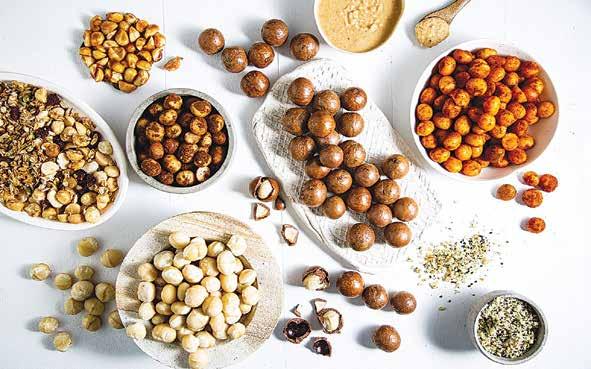
National Science (HVN) Challenge, was conducted for inclusion in the New Zealand Food Composi tion Database, managed by Plant & Food Research and jointly owned by the Ministry of Health.
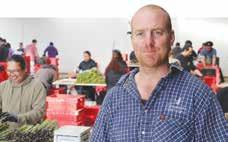

“Knowing what nutri




ents are at dietary sig nificant quantities in foods allows consumers to choose a diet person alised to meet the cri teria of importance to them,” says Dr Carolyn Lister from Plant & Food Research.
“Having high con centrations of nutrients known to be good for health also allows com panies to highlight these nutrients in the market ing of their products, giving them way to stand out against competitors.”
Torere Macadamias says it will use the infor mation to support expan sion of its product range. The company is planning to launch a new market ing campaign to maxi mise and highlight the high nutrient value of
their macadamias in early 2023.
“Torere Macadamias nuts are reputably the biggest and best tasting in the world. Knowing more about them is useful for both consumers look ing for healthy choices and for growers looking to potentially incorporate macadamias into their own orchards,” says Van essa Hayes. “This analysis of six of our best per forming varieties, based on 30 years of research trials, provides validation for these varieties being the base of New Zea land’s macadamia indus try’s future growth, with an aim of 1,000 hectares by 2029.”
Joanne Todd, director of the High-Value Nutri tion National Science Challenge, believes this research has the poten tial to give New Zea land-grown macadamia a competitive advantage.
11 DECEMBER 2022 HORTNEWS
“Torere Macadamias nuts are reputably the biggest and best tasting in the world.”
HORTNEWS Introducing Hort News, a national publication serving the needs of our booming horticulture sector. Distributed with the leading national farming publication Rural News, Hort News will be delivered to all key horticulture regions nationwide. It is the complete solution for readers and advertisers, covering every aspect of the wider horticulture industry – news, agribusiness, management, markets, machinery and technology. Contact: STEPHEN POLLARD Auckland Sales Representative Ph 021 963 166 LISA WISE Waikato Sales Representative Ph 027 369 9218 RON MACKAY Wellington Sales Representative Ph 021 453 914 KAYE SUTHERLAND Christchurch Sales Representative Ph 021 221 1994 RURAL NEWS TO ALL FARMERS, FOR ALL FARMERS Publishers of • It’s the one-stop way to reach the horticultural sector • News and information for all types of growers • 10,000 nationwide distribution • Sent out with the trusted and established publication Rural News HORTNEWS NOVEMBER 2021 ISSUE 19 2624-3490 prin ISSN 2624-3504 WWW.HORTNEWS.CO.NZ Bumper cherry –predictedcrop Page 7 Sweet result for hort! SOME HORTICULTURE farmers are also bracing for financial relief from the proposed free trade agreement between New Zealand and the United Kingdom. Apple, pear and onion growers are among those set to benefit althoughers.notasbigmajormeatanddairyexport AlanNZApplesandPearschiefexecutive PollardsaysatthemomenttheUK is a $100 million market for growers, consistently ranking in the top two or three. “We have quota between August and December where volume above that quota attracts an 8% tariff,” he told Hort News Under the proposed FTA, the tariff on pears will be removed on day one, with the tariff on apples reducing over three years “So, there is some financial relief andwebenefitfromamorewelcoming regulatory environment,” says Pollard. Onion growers will face zero tariff from day one. The tariff on New Zea land onions is currently 8%. New Zealand currently exports $11 million worth of onions to the United King domOnionsannually. NZ chief executive James Kuperus says the FTA will ensure that this country’s onion exports continue to grow as the world comes to terms with Covid. “Trade and exporting ben efits a diverse range of New Zealand businesses,” he says. “Without clear trading arrange ments, improved market access and reduced tariffs, it is extremely difficult totoexportfromthebottomoftheworld larger economies like the United Kingdom. “Of immediate benefit to the onion sectoristheexpectationoftariffsbeing eliminated on onions, once the agree ment comes into force.” The New Zealand Government announced the details of an “in-prin ciple” New Zealand-UK FTA last week as trade officials neared completing the deal after little more than a year of negotiations. Kuperus says the NZ onion sector is extremely grateful for the hard work of New Zealand’s nego tiatorsanddiplomatswhohaveworked tirelessly to conclude this agreement. “The New Zealand team has had atjoinZoomcallswiththeircounterparts night,extremelyinconvenienttimesofthe for example.” The conclusion of this agreement willbenefitoniongrowersandregional communities, from Pukekohe to Can terbury. Onions are an important rota tion crop for many vegetable growers. Having onions in a rotation allows growers to rotate between other crops such as lettuces, potatoes, carrots etc, which helps to control pests and diseases. In 2019, the NewZealandonionindustrywasworth $200 million back to the grower, 85% of which came from exports. Mean dealwhileApicultureNewZealandsaysthe industrywillbeagreatoutcomeforthebee andwillimprovecompetitive nessinoneoftheirlargestexportmar kets. The UK consistently ranks as one of top three export markets for New Zealand honey and is worth $70 mil lion annually. “We have strong ties with UK customers, with a long his tory of exporting high-quality honey products there. However, the current in-quota tariff rate of 16 per cent hasbeenasignificantbarriertotrade,”says KarinKos,chiefexecutiveofApiculture New Zealand. Sudesh Kissun sudeshk@ruralnews.co.nz GETTING READY! MANGAWEKAASPARAGUSmanager SamRaineyoverseesan80hectare asparagusinthecentralNorthIsland. WhenHortNewsvisitedtheproperty inlateSeptember,Raineyandhisstaff wereinthefinalstagesofpreparing fortheharvest.Thepackhousewas beingsetupandatthesametimethe firstspearsofasparaguswerestarting toappear.Whilethetotalsizeofthe propertyis80hectares,theywillpick just65hectaresthisseason–which equatestoupto250tonnes. Seestorypages4and5. Replacement Spray Pumps & Spray Kits Webbline Agriculture is a direct importer/reseller of a full range of pumps from market-leading manufacturers, along with service kits and accessories. Large range in stock. Dealer enquiries are welcome. View online - www.webbline.co.nz Contact Ben 021 819 482 | ben.boakes@webbline.co.nz WAIKATO •CANTERBURY • SOUTHLAND branches NOW PUBLISHED MONTHLY! To book your advert contact your local sales rep
Analysis of Torere Macadamias nuts, grown in the Eastern Bay of Plenty, have shown they have promising concentrations of three key nutrients. COPYRIGHT TORERE MACADAMIAS
NZ cherries on top!
AN EARLY Chinese New Year may be a challenge for New Zealand cherry exporters trying to tap that lucrative market this season.

New Zealand premium cherries are a favou rite luxury gift for Chi nese New Year across East and Southeast Asia. Next year’s festival starts on January 22 and is linked to the lunar cycle. The date varies each year by up to a month – and Janu ary 22 is about as early as it ever gets.
It will be a challenge getting the crop rip ened, picked, packed and shipped out in time, says Central Otago cherry industry consultant and marketer Sharon Kirk.
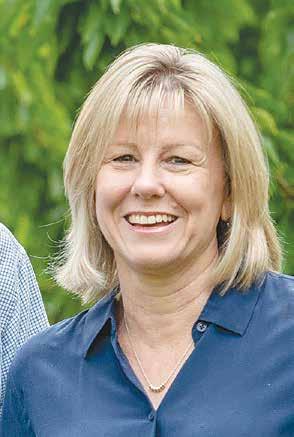
“Some of the varieties won’t be, because they’re just not going to be ready before Chinese New Year,” she told Hort News.
However, with predic tions of “a nice, long hot summer” there is a poten tial for record exports this season.
“There’s certainly a big fruit set out there,” Kirk says.
With her husband Ross, Kirk has been involved through their
company Hortinvest. The company specialises in working with landown ers to establish and run cherry orchards, doing everything from raising the initial finance to mar keting the fruit.
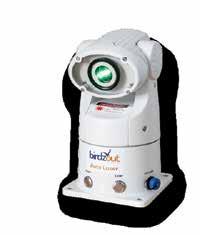
She recently attended Asia Fruit Logistica –described as Asia’s pre mier fresh fruit and vegetable trade show – in Bangkok November 2-4.
Kirk attended as mar keting manager for two
orchards, Southern Fruits International and Tarras Cherry Corp. This will be the first full harvest season for both but there was a huge amount of interest at the show for New Zealand cherries, she says.
Kirk’s confidence for the season matches that of Rabobank, which is predicting record cherry production volumes across most of the South ern Hemisphere.
IN A recent report, the agri business banking specialist notes that Chile is by far the largest exporter of cherries in the Southern Hemisphere – accounting for 96% of total exports last season.
The remainder comes from South Africa, Argentina, Australia and New Zealand.
Report co-author, Rabo bank agricultural analyst Pia Piggott, says Chile’s exports are expected to continue to increase.

“We’re also expecting record cherry volumes across all other major Southern Hemisphere cherry exporters other than Australia,” she says.
“This will test how the ‘return to normal’ post Covid is working, and how the main export destination markets will behave. With China a key export market for Southern Hemisphere cherry producers, including New Zealand, all eyes
will be on the Chinese market to see how the country’s continuing zero-Covid policy impacts demand.”


Piggott says New Zealand’s cherry industry remains rela tively small with less than 1,000 ha of plantings, mostly in Central Otago. That compares with more than 2,500 ha in Australia.
However, New Zealand’s reputation for producing quality cherries means New Zealand cherries command high prices, second only to Japanese fruit.
“Cherries from New Zealand are predominantly bought as a luxury gift in celebration of the Chinese New Year,” Piggott adds. “With the largest export volumes going to Taiwan, followed by China, Vietnam and Thailand.”
She points out that New Zealand cherry exports have fallen in recent years due to La
Nina weather conditions and Covid-related logistical issues.
“Over the next few years growing conditions should become more favourable as La Nina comes to an end in early 2023, and we expect to see New Zealand cherry produc tion and export volumes improve from pandemic levels.”
The Rabobank report says Southern Hemisphere cherry producers all face similar chal lenges in the form of increasing competition and narrowing margins due to elevated production costs.
“Chile, Argentina, and Australia are all moving in the same direction in terms of improving the efficiency in their processes, focusing on high-quality production, and diversifying their destination markets,” Piggott concludes.
DECEMBER 2022 12 HORTNEWS
@rural_news facebook.com/ruralnews
SOUTHERN HEMISPHERE CONFIDENCE HIGH
SUPPLIED.
Rabobank Agricultural Analyst Pia Piggott
© SCOTT STRAMYK 2022
Central Otago cherry marketer Sharon Kirk.
SUPPLIED/CENTRAL LAKES PHOTOGRAPHY
0800 654 320 info@maintracgroup.com www.maintracgroup.com birdzout for smart bird control ® Contact us today for more information Smart Bird Control Solutions
Nigel Malthus
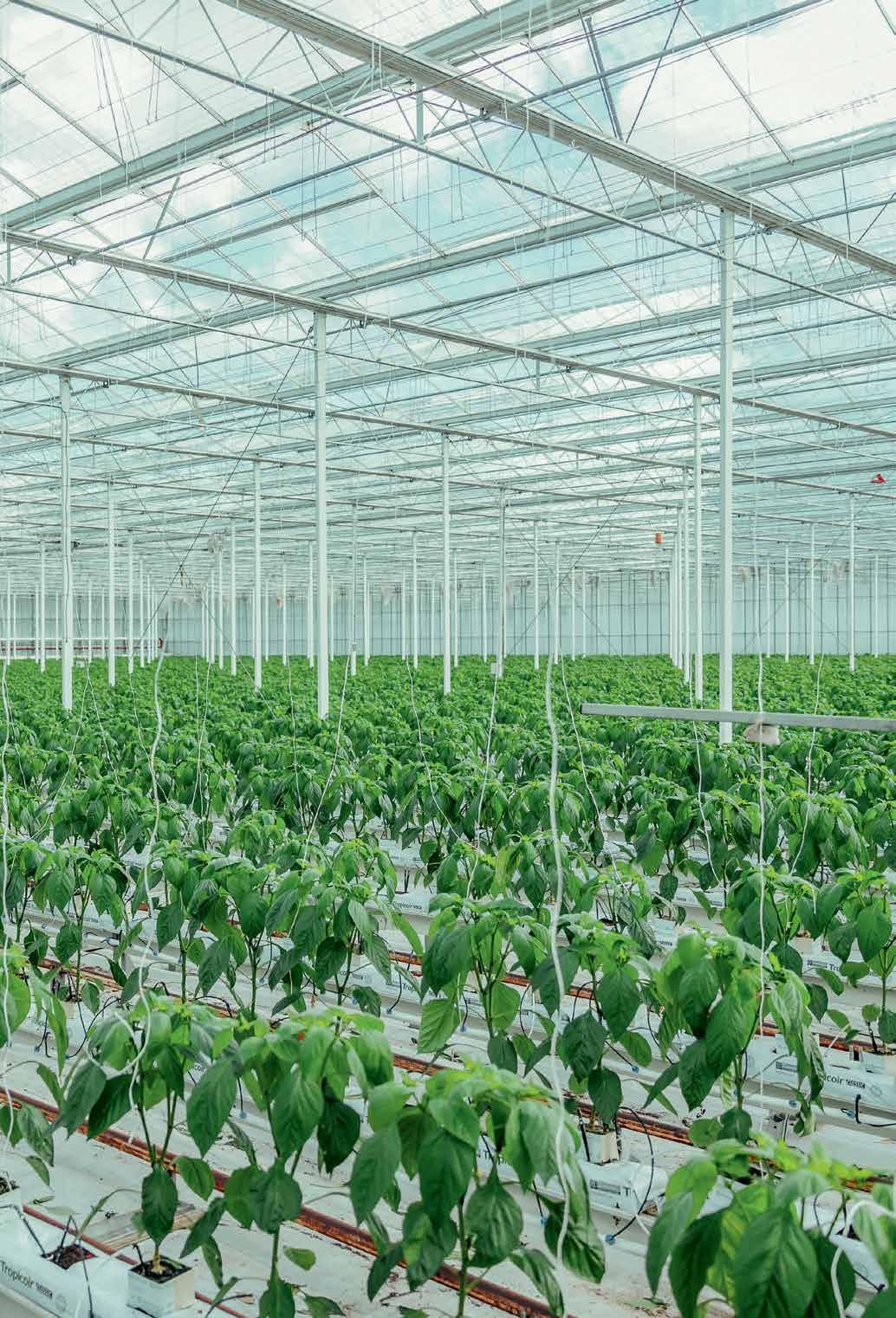

low carbon crops Its time to make the transition, tap into the benefits of decarbonisation and prepare your business for the future. The Covered Cropping Decarbonisation Pathway will give growers access to: • International expertise • Best practice guidance • Bespoke tools and resources. Discover more at eeca.govt.nz/coveredcropping
Say hello to
Cutting carbon paying off for Central Otago orchardist
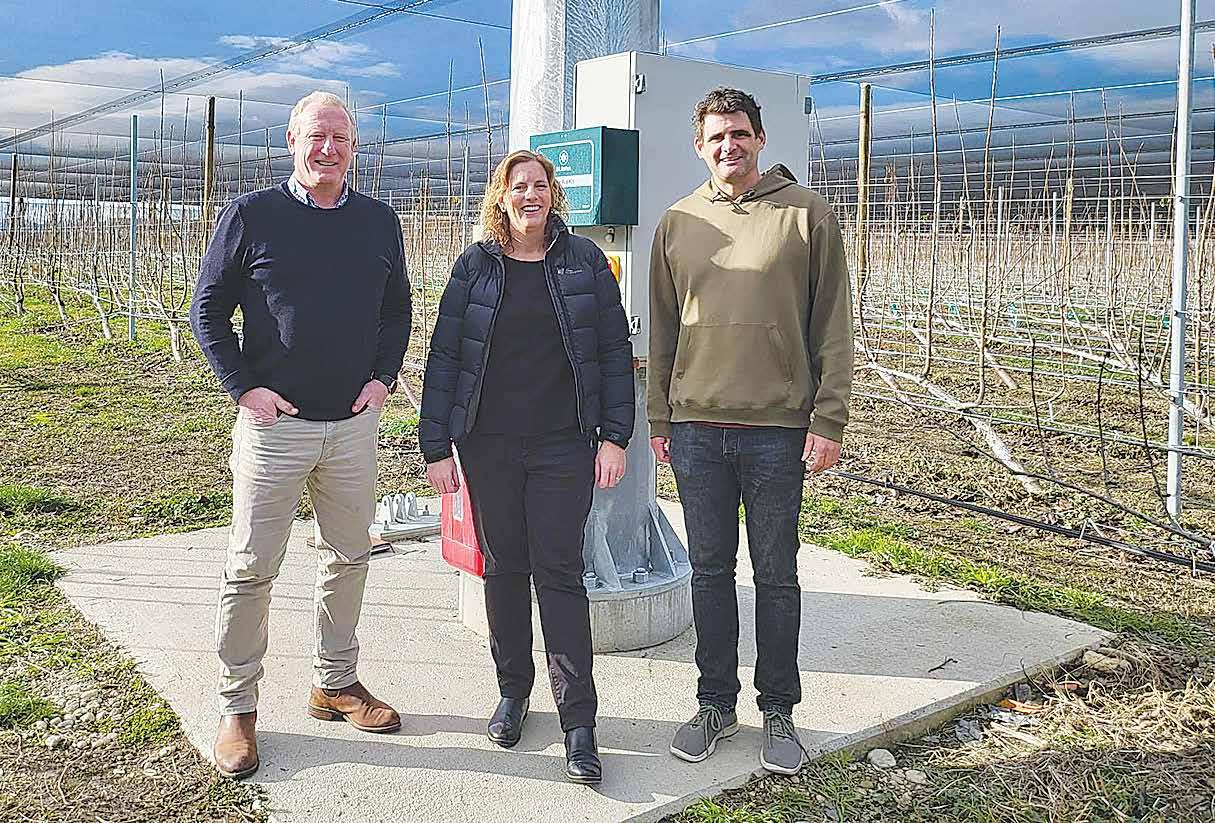
MIKE CASEY, owner of the world’s first zero fossil fuel orchard, shared his journey to fully electrify his six-hectare orchard at the New Zealand Agri cultural Show in Christ church in November.
Forest Lodge Orchard’s entire commercial opera tion – which is located in Central Otago – includes New Zealand’s first elec tric frost fighting fans, plus irrigation, tools and vehicles all powered by electricity generated and stored on farm using solar and batteries.
Casey is currently tri alling a converted elec tric tractor and expects delivery of the country’s first electric tractor next year. He says it is impor tant not to let perfection be the enemy when it comes to making changes on-farm.
“We need to start by looking at the choices we
make for things we can control like the equip ment we use on our farms,” he explains.
“I have gone ahead and done everything I can do to eliminate reliance on fossil fuels. But farm ers can also adopt a stepby-step approach if they want to start going down the same path.”
Casey reckons one option for gradual change is to replace older equip ment at the end of its lifespan with new electric equipment.
“I know that not everyone can replace everything all at once, especially if they are not starting from scratch like we did, so I think another way to look at it is when things need replacing.”
During his presentation Casey provided itemised data showing the payback periods and the amount
TAILORED INSURANCE
One of the key barriers to Casey setting up a fully electric operation was finding an insurance product that would cover the risk of power cuts to his electric frost fighting fans during the vulnerable spring growing months when young cherries must be protected from the hard frosts in Central Otago.
To be completely fossilfuel free, Casey wanted to avoid using a dieselpowered backup generator.
of carbon saved for the full electrification of his farm. This included upgrades for connecting to the grid and the purchase of frost fighting fans, tractor conversion and equipment, an electric sprayer and an electric vehicle.
However, he struggled to find an insurance provider that would protect his business against the risk to his crops posed by power cuts.
That was until he started working with GSI Insurance Partners Christchurch director Sean Lysaght and Vero to create an innovative insurance policy that met his unique needs.
“When you are determined to create real change and do it on a large scale you need to remove the
“For the full electrification of everything on farm there is an incremental payback of seven years and a full payback period of 13 years.”
The orchard harvested its first crop of fossil fuel free cherries last year and
blocks that might stop others from following you.”
When Lysaght started working with Casey to create an insurance product to fit the unique circumstances, he needed to find an insurance underwriter who would be willing to think creatively about the situation.
“We approached Vero, and they were willing to collaborate with us to create a new and innovative insurance policy that would cover Mike for any loss of
he says the key to improv ing the payback of electri fication and solar energy is marketing a premium product which consumers are willing to pay more for and backing this up with hard evidence.
To help other farm ers with this, Casey has
product due to power cuts.”
After spending around 18 months fine tuning the insurance policy, which used interruption cover as a base, Lysaght and Vero created a solution that fits Casey’s unique situation.
Lysaght believes more farmers will be seeking tailored insurance solutions in the future as they move towards implementing sustainable farming to mitigate environmental issues.
created a new NZ0 cer tification which is inde pendently audited by AsureQuality. This cer tification has strict rules around fossil fuels which means that food produc ers cannot offset their emissions but instead need to provide evidence
of change regarding fossil fuel use.
“This is a vital part of providing consumers with an authentic certifica tion, because the words ‘carbon neutral’ do not necessary mean that the consumers are getting a sustainable product.”
DECEMBER 2022 14 HORTNEWS
GSI Partners Christchurch director Sean Lysaght, Vero executive manager of rural insurance solutions Sonya Whitney and Forest Lodge Orchard’s owner Mike Casey worked together to create an innovative insurance policy which covers Casey’s 100% electricity-powered cherry orchard for losses relating to power cuts.
Cameras help with weed control
Mark Daniel markd@ruralnews.co.nz

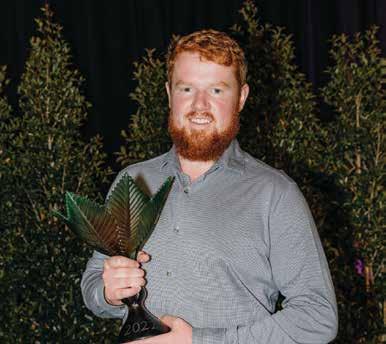
THANKS TO modern camera systems, mechanical weed control using Steketee hoeing machines can now be precise and efficient, with improved control and row detection achieved with a second camera.

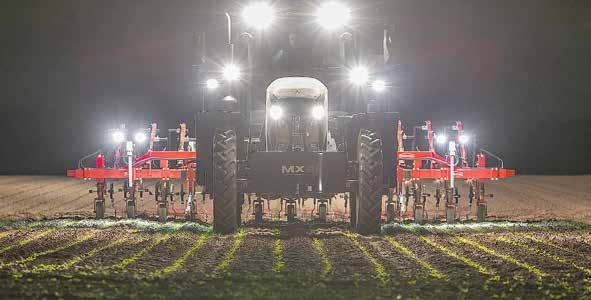
The new Combi Cam Mode, which is
automatically activated at the factory, generates a superimposed image from both cameras.
As a result, the system works using twice as much visual information, which ensures even more precise row detection.
This also offers great advantages, especially in heterogeneous, patchy crops.
There is also much
PRECISION SOWING
RECENTLY INTRODUCED by Norwood, the Vredo DZ5 platform is designed for over-seeding grass or flower mixtures in the FineTurf sector.
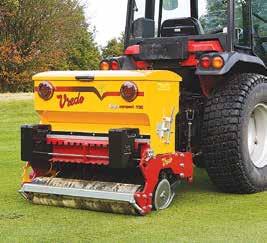
The single, compact series is unique and versa tile. The indestructible overseeder is equipped with a single-row, double disc system, with a row spac ing of 70mm. A compact construction layout makes the machine easy to lift and better suited to small tractors. Meanwhile, the 220mm roller makes the machine shorter and gives a high peak pressure for a perfectly smooth result.
Weight savings in construction means there is room for a 68% larger seed hopper, offering longer periods of work before a refill is required, with a new seed level indicator providing information to the driver at a glance.
The double disc system has been improved to guide the seed for even longer into the cut, with the 250mm diameter discs requiring less weight to make a perfect cut. In circumstances where penetra tion into the ground is difficult, additional weights can be added to improve penetration.
The Single Compact comes in four working widths of 100, 140, 180 or 220cm. All models are mounted on the three-point linkage. www.norwood.co.nz
less stress and fatigue for drives, as manual switching between the






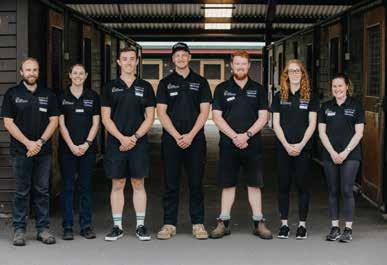

two cameras is no longer necessary. In addition, it is still possible to select
only
camera
Alternatively, the AutoSwitch Cam Mode can be activated via the settings, so that the machine is automatically controlled via the camera that receives the best image. The system switches as soon as the image quality falls below a set threshold. This ensures consistently precise row guidance until the next turning operation.
The Combi Cam and AutoSwitch Cam functions are also available for existing LEMKEN Steketee hoeing machines via a software update.
15 DECEMBER 2022 HORTNEWS
one camera with an extensive view if, for example, the second
is operating outside the field boundary.
Modern camera systems make mechanical weed control using Steketee hoeing machines precise and efficient.
Very popular with nurseries for trimming roots on seedlings and much more 0800 SelfSharpening Countdown Innovation Award Winner Courtney Chamberlain Second place Jodie McDonnell Third Place Amy Clark Participation Regan Judd, Solomon Caldwell, Guillaume Chabbert, Sam Bain Fruitfed Supplies Leadership Award Courtney Chamberlain Countdown Best in Sector Award Courtney Chamberlain YOUNG HORTICULTURIST SUPPORTERS YOUNG HORTICULTURIST OFFICIAL PARTNERS YOUNG HORTICULTURIST AFFILIATED SUPPORTERS FRIENDS OF THE COMPETITION Bev McConnell OVERALL WINNER Regan Judd – T&G Global SECOND PLACE Sam Bain Villa Maria THIRD PLACE Courtney Chamberlain Hadstock Farm Horticentre Trust Sustainability Award Courtney Chamberlain Bayer Best Practice Award Regan Judd RNZIH Best Speech Award Sam Bain T&G Fresh Practical Components Award Regan Judd Countdown Award Regan Judd, Solomon Caldwell, Guillaume Chabbert, Sam Bain, Courtney Chamberlain, Jodie McDonnell, Amy Clark For information on entering or supporting the competition in 2023 please visit the website www.younghort.co.nz This year’s finalists (L to R): Sam Bain, Jodie McDonnell, Solomon Caldwell, Guillaume Chabbert, Regan Judd, Amy Clark, Courtney Chamberlain
The Vredo DZ5 platform is designed for over-seeding grass or flower mixtures.
New tractors narrow field
JOHN DEERE has extended its offering to the New Zealand orchard, tree nut and vineyard industries with the intro duction of the new 100plus horsepower John Deere 5ML Series of cab tractors.
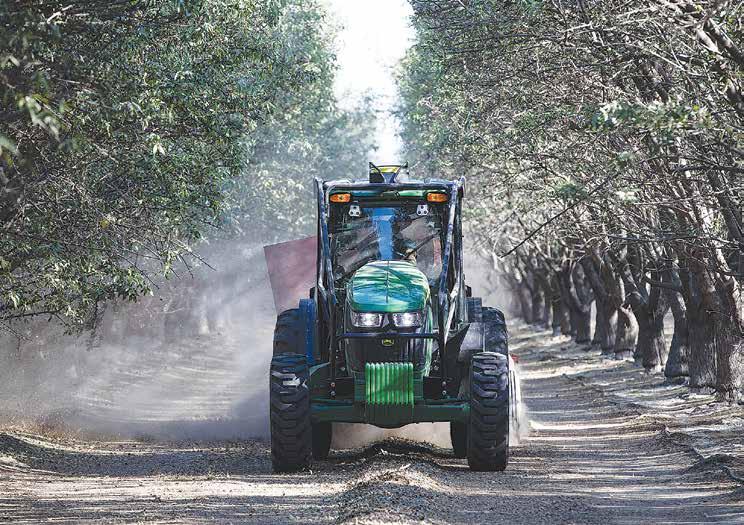
The tractors come with engine outputs of 105, 120, and 130hp, in two configurations. With the 5ML and the 5ML-Narrow offering front-axle work ing widths as narrow as 71 inches on the former and down to 61 inches on the latter.
Transmission choices are the easy to use Pow rQuad PLUS. This offers 16F/16R speeds from 1.9 to 34km/h or thePowr8 with Creeper, deliver ing 32F/16R speeds with a max speed of 40 km/h or with the creep set engaged – as slow as 350 m/h.
“The 5ML will bring unprecedented power to John Deere’s orchard tractor offering, with a machine offering pre mium features at a size suited to exacting appli cations,” says John Deere Australia and New Zea land production system manager Stephanie Gersekowski. “While also delivering superior oper
ator comfort as well as levels of precision agri culture technology not before seen in this class.”
Equipped with a lowprofile cabin, the 5ML features PFC Hydrau lics. This is a load sensing system that initiates flow on-demand, but when it is no longer needed, the pump returns to low pressure and to standby

mode. This helps to improve fuel efficiency by up to 30%.
Both configurations are equipped with pro grammable LED light ing and can be optioned with front hitch and – if required – a front PTO for added versatility. There is also choice of an easyto-use PowrQuad TM PLUS or Powr8TM trans
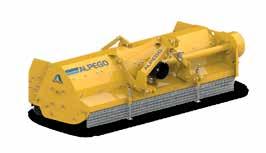

mission. The John Deerebuilt cab offers the ideal dimensions to fit down tight orchard rows. Mean while, at the tractor’s heart is a reconfigurable in-dash, three-screen LCD display that allows oper ators to customise their view. This makes it easy to set up guidance lines and on-the-go adjust ments with shift track, as
well as establish head lands with the encoder dial.
“The cab has a flat floor, spacious headroom and ergonomic controls to make for ease of use across a variety of oper ator experience, while also delivering extra com fort during long working days,” Gersekowski adds. The Category IV Fil
tration System provides additional cabin filtration and pressurisation. This prevents external chemi cal and particulate haz ards from entering the operator enclosure and eliminating the need for personal protective wear.
For practical operation, a new Limb Lifter kit can be added to gently move low hanging branches,
thus reducing any poten tial for damage to the tree or the tractor.
As would be expected, the 5ML series makes precision farming capa bilities available to grow efficiency. This includes JDLinkTM – an indus try exclusive in this class to track machine data remotely.
“This is ideal for cus tomers with fleets of trac tors, as it allows them to manage equipment loca tions and proactively monitor machine health and productivity,” Geres kowski explains. “As well as deliver their team with the information and direction needed to finish jobs accurately and on time.”
5ML is Greenstar/ ISOBUS Ready for imple ment connectivity. This helps to accurately apply liquids and dry products in environments where a GPS signal is not avail able and document those applications.
Similarly, the Auto TRACTM option offers customers the ability to eliminate implement overlap and optimise machine efficiency when completing jobs such as spraying, planting, and mowing.
The 5ML and 5ML Narrow are available for immediate order.

DECEMBER 2022 16 HORTNEWS
Mark Daniel markd@ruralnews.co.nz
a
100-plus
cab tractors with its 5ML
ALPEGO MULCHERS FEATURE: • 2 YEAR WARRANTY • Built from SWEDISH HIGH TENSILE STEEL • Double Skin Body • High Quality 4 or 5 Cog Belt Drives • High Speed Gearboxes producing high blade speeds • Belt Guard Protection • Oversize Rotor and Roller Bearings TR26 Orchard and Grass Mulchers 1.4m – 1.6m Widths • 40 - 80HP Rated Low Profile Body – Anti Snag • Hammer Flails Patented Mulching Chamber • Adjustable Rear Roller Adjustable Offset Linkage TT93 / TT97 Stubble and Scrub Mulchers 2.5m, 3.0m, and 3.2m widths available • 100 – 160HP Rated High Profile Body – For Heavy Conditions • Y Flails for low power and clean cutting (Option of Hammer) • Optional Skids / Rear Roller or Wheels Ideal for Grass/Gorse/Crop Stubble/Rushers/Scrub For more information or to find your nearest Origin Ag dealer go to * Normal lending criteria and special conditions apply. $14,500 +gst FROM $11,500 +gst NOW TR36 Orchard and Grass Mulchers 2.0m Widths • 50 - 100HP Rated Low Profile Body – Anti Snag • Hammer Flails Patented Mulching Chamber • Adjustable Rear Roller Adjustable Offset Linkage $8,495 +gst FROM This is a LIMITED OPPORTUNITY to pick up A GREAT DEAL! All machines are NEW, and come with a 2 YEAR FACTORY WARRANTY! BE QUICK STOCK IS LIMITED!
John Deere has introduced
new
horsepower range of
Series.

































































